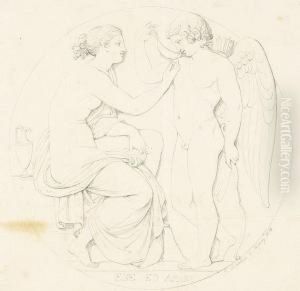Ridolfo Schadow Paintings
Ridolfo Schadow was a German sculptor, born on July 9, 1786, in Rome, where his father, Johann Gottfried Schadow, a prominent German neoclassical sculptor, was active. His father was the director of the Prussian Royal Academy of Arts and also renowned for works such as the Quadriga atop the Brandenburg Gate in Berlin. Ridolfo grew up in an environment that was deeply entrenched in the arts, surrounded by influential figures of the era, which significantly impacted his career path.
In his formative years, Ridolfo was trained by his father and was heavily influenced by the neoclassical style, which is characterized by a return to the aesthetics of classical antiquity. He further honed his skills by studying the works of ancient Greek and Roman artists as well as contemporary Italian sculptors. Ridolfo's talent was recognized early on, and he received commissions that allowed him to establish his reputation.
Throughout his career, Ridolfo Schadow focused primarily on sculptural works, which often featured mythological themes and were marked by their grace and delicacy. He is known for his marble sculptures, which exhibit a refined elegance and attention to detail. Unlike his father, whose works often displayed a robust and monumental character, Ridolfo's sculptures were more intimate and tender.
Although he lived and worked in Rome for most of his life, Ridolfo's work was well-received in Germany as well, and he contributed to the diffusion of neoclassical aesthetics across Europe. His works were appreciated for their technical precision and the emotional depth they conveyed. Despite his success, Ridolfo's career was cut short when he died at a young age of 36 on January 31, 1822, in Rome.
Ridolfo Schadow's legacy is somewhat overshadowed by the towering reputation of his father, but he is remembered as a skilled practitioner of neoclassical sculpture in his own right. His works can be found in various collections and museums, and they continue to be studied for their contribution to the neoclassical movement during a period that was rich in artistic innovation and exchange.
